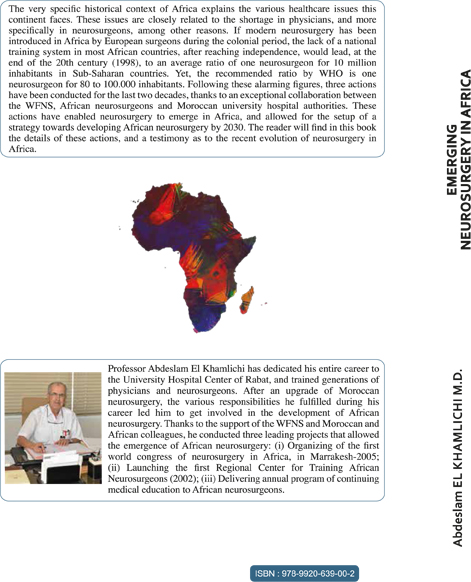Cover note
"Emerging Neurosurgery in Africa" is a book that was published a year ago by Doctor Abdeslam El Khamlichi, WFNS Honorary President and Professor Emeritus of Neurosurgery at Mohammed V University, Rabat, Morocco. The author is among the pioneer African neurosurgeons who dedicated his entire career to train generations of Moroccan and African neurosurgeons, to upgrade neurosurgery in his country, and to develop African neurosurgery with an unprecedented support from the WFNS.
The book is a masterpiece document on the recent evolution of Neurosurgery in Africa during the last three decades, and its remarkable relationship with the WFNS. The first part of the book explains the specific colonial context of Africa. Instead of an early introduction of modern neurosurgery with the first healthcare system by the colonial powers, the colonial medical Diaspora failed in training local health professionals which resulted in a severe shortage in physicians, including neurosurgeons. The lack of national training centers in most African countries after independence, would lead at the end the 20th century (1998) to an average ratio of one neurosurgeon to 10 million inhabitants in Sub-Saharan African countries. Due to their limited number, African neurosurgeons would not be able to participate in international activities until the beginning of the 21st century, and would not gather up in an active continental association until 2012.
Following a report presented by the author in 1999, the WFNS took two historical initiatives to support African neurosurgery: the organization of the first world congress of neurosurgery in Africa (Marrakech, 2005) and the accreditation of regional training centers to train young African doctors in neurosurgery in their continent. The first one was set up in Rabat, the WFNS-RTC (WFNS-Rabat Reference Center for training young African neurosurgeons, or WFNS-Rabat Training Center), in 2002. The book describes how the enthusiasm generated by the World Congress in Marrakech and the results of 16 years activity of the WFNS-RTC, have succeeded in introducing neurosurgery in 20 Sub-Saharan African countries, to increase the number of neurosurgeons in this region by five times, and the number of national training centers by six times. This evolution enabled African neurosurgery to emerge and step out of the shadow, which ended up in setting up the CAANS (Continental African Association of Neurosurgical Societies), in 2012. The fourth part of the book opens the gates on the future of neurosurgery in Africa, proposing a development strategy by the year 2030, in order to achieve an acceptable level and meet the needs of African populations.
As one of the main initiators and actors in all these projects, the author brings his testimony on the last three decades of fruitful collaboration between the WFNS and African neurosurgeons, which led to the emergence of Neurosurgery in the African continent. The book is introduced by forewords written by Moroccan, African and international eminent experts. He concludes with articles written by young African neurosurgeons already back home after having finished their training in the WFNS-RTC. These young neurosurgeons report their experience, which makes up a testimony to the success of this training model.
The author narrates all these events in a direct style, with many original and stimulating experiences, such as the approach adopted to advance neurosurgery in Morocco and Africa, the positive actions taken after the failure of first Marrakech bid in Berlin (1995), or the mobilization of Moroccan authorities and neurosurgeons around the WFNS-RTC. Such experiences make the reading of the book instructive and rewarding.
Through this experience of the recent history of African neurosurgery and the role of the WFNS in the process, we hope this book urges young generations in the WFNS and Africa, to step back when witnessing the achievements of the Federation and the advances of African neurosurgery.
The editor




